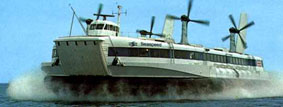The Hovercraft
Christopher Cokerell
The Hovercraft was invented in 1955 by the British engineer Christopher Cokerell. His early invention began life as a pair of tin cans connected to a vacuum cleaner. This experiment demonstrated that air pressure could produce enough pressure to lift a vehicle off the ground.
The Hovercraft was launched in the English Channel in 1959 and has been used throughout the world since for commercial and military purposes. The clear advantage of this type of vehicle is that there is very little friction between the ground and the bottom of the Hovercraft.
The principal upon which the Hovercraft works is quite a simple one. Air has considerable power when placed under pressure. When this air is compressed it has the ability to drive machines. The Hovercraft uses this compressed air to lift itself above the surface of water or ground. Two jets of sucked in air are forced beneath the vessel. The cushion of air that is created is surrounded by a curtain or skirt of material. The skirt holds the air in to form a high-pressure cushion. This skirt does not drop down vertically but is tapered in at the bottom, so that when the air reaches the ground it fills up the space inside the circle instead of escaping outwards. The air that is contained inside the skirt develops into a series of eddies, whirling around and around like rollers. It continues to do this until the pressure is so great that no more air can squeeze in. At this point the pressure that is created is high enough to lift the vehicle off the ground. The vehicle hovers safely on its own cushion of air.
The Hovercraft moves easily as well over all types of surfaces. It needs no roads and is not affected by waves on the water. As the vehicle is raised roughly 15 inches above the surface of the water or ground it is confronted by no obstacles.
